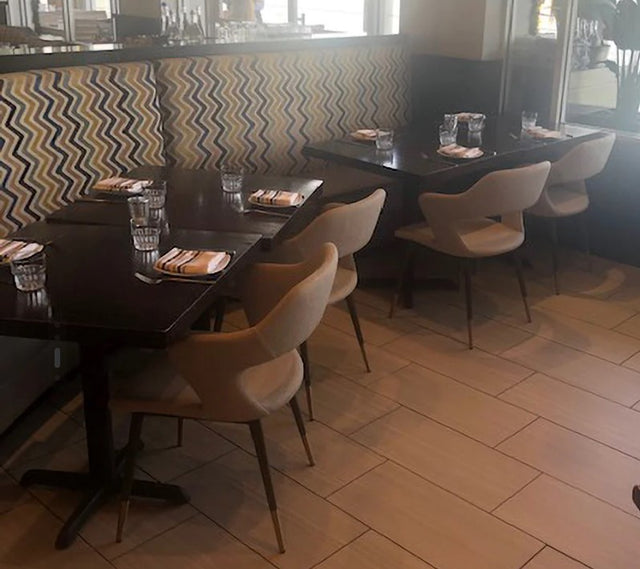Standard Sizes and Spacing Guidelines for Restaurant Booths
In the restaurant industry, the layout and design of the dining area play a crucial role in creating a welcoming and comfortable atmosphere for guests. One key element to consider when planning the seating arrangement is the size and spacing of restaurant booths. Booths are a popular choice for many establishments as they offer privacy, comfort, and a sense of coziness. In this article, we will explore the standard sizes and spacing guidelines for restaurant booths, and discuss the factors to consider when determining the appropriate dimensions for your particular establishment.
Understanding the Importance of Booth Size and Spacing
When it comes to restaurant booths, the size and spacing can greatly impact customer comfort and satisfaction. The right booth size allows guests to sit comfortably without feeling cramped or restricted, while adequate spacing ensures easy maneuverability and accessibility throughout the dining area. Let's delve into the details of how booth size and spacing can affect your customers' overall dining experience.
The Impact on Customer Comfort and Satisfaction
One of the primary reasons why people choose to dine at a restaurant is to enjoy a pleasant and relaxed experience. Booths contribute significantly to customer comfort and satisfaction. A booth that is too small can make guests feel claustrophobic, while one that is too large can create a sense of isolation and distance. Striking the right balance is crucial to ensure that customers feel comfortable, allowing them to focus on enjoying their meal and the company of their dining companions.
Moreover, comfortable seating enhances customers' perception of the overall dining experience. When guests feel comfortable and at ease, they are more likely to stay longer, order more items, and potentially return for future visits. On the other hand, uncomfortable seating can lead to a negative impression and discourage customers from revisiting your establishment.
Imagine this scenario: A couple walks into your restaurant, looking forward to a romantic dinner. As they are led to their booth, they are pleasantly surprised by the spaciousness and coziness it offers. The booth is perfectly sized, allowing them to sit close together while still having enough personal space. They sink into the plush cushions, feeling instantly relaxed and ready to indulge in a delightful culinary experience. This level of comfort sets the stage for an unforgettable evening, leaving a lasting impression on the couple and ensuring their return in the future.
Maximizing Restaurant Space and Efficiency
The size and spacing of restaurant booths also have a significant impact on the overall layout and efficiency of the dining area. Properly sized booths can help you maximize the use of available space, allowing you to accommodate a larger number of guests. This is particularly important for establishments with high customer volume and limited space.
Efficient spacing between booths ensures that customers and staff can move around the dining area easily, reducing the risk of accidents or inconveniences. It is essential to strike a balance between maximizing the seating capacity and creating a comfortable and relaxed environment for guests.
Consider this: You own a popular restaurant located in a bustling city center. Space is at a premium, and every square foot counts. By carefully selecting the right booth sizes and spacing, you are able to accommodate more customers without compromising their comfort. The strategic placement of booths creates a seamless flow in the dining area, allowing your staff to provide efficient service while ensuring that guests have enough personal space to enjoy their meals. This optimal use of space not only increases your revenue potential but also enhances the overall dining experience for your valued customers.
Key Factors to Consider When Determining Booth Size
Restaurant Theme and Style
Every restaurant has its unique theme and style, and the choice of booth sizes should align with this overall concept. For instance, if your establishment is designed to reflect a rustic and cozy atmosphere, smaller booths with wooden frames and plush upholstery can create a charming and intimate setting. On the other hand, if your restaurant has a more modern and sleek ambiance, larger booths with clean lines and minimalist design may be preferred.
Furthermore, when considering the restaurant theme and style, it's essential to take into account the color scheme and overall decor. The upholstery of the booths should complement the color palette of the restaurant to create a cohesive and visually appealing dining space. Additionally, incorporating decorative elements such as throw pillows or unique lighting fixtures can enhance the ambiance of the booth seating area.
Expected Customer Volume
The anticipated customer volume is a crucial consideration when determining booth size. Restaurants that cater to large groups or families should offer booths that can accommodate more people comfortably. On the other hand, establishments targeting couples or small parties may opt for smaller, more intimate booths to create a cozy and romantic dining experience.
Moreover, analyzing peak hours and busy periods can help determine the optimal booth size to efficiently manage customer flow. By strategically placing different-sized booths throughout the restaurant, you can balance the seating capacity and ensure a smooth dining experience for both guests and staff. Consideration should also be given to factors such as wait times and table turnover rates to maximize the restaurant's revenue potential.
Accommodating Different Group Sizes
It is important to consider the average group size that your restaurant expects to accommodate. While larger booths are ideal for accommodating groups, it is also essential to provide options for smaller parties or individual diners. Offering a mix of booth sizes allows you to cater to a wider range of guest preferences and maximize your seating capacity.
Additionally, incorporating flexible seating arrangements such as movable tables or adjustable booth dividers can further enhance the versatility of your seating layout. This adaptability enables the restaurant to easily accommodate varying group sizes and adapt to changing customer preferences throughout the day. By prioritizing both comfort and functionality in booth design, you can create a welcoming and efficient dining environment for patrons of all group sizes.
Standard Dimensions for Restaurant Booths
When designing a restaurant layout, choosing the right booth dimensions is crucial to ensure comfort and functionality for diners. Single booths, the most common type, typically range from 42 to 48 inches in length and 18 to 24 inches in depth. The height of single booths usually falls between 36 and 42 inches, providing ample space for one to two individuals to enjoy their meal comfortably.
Double booths, on the other hand, are ideal for larger groups or families dining together. These booths are significantly longer, measuring around 84 to 96 inches in length and 18 to 24 inches in depth. The height of double booths remains consistent with single booths, ranging from 36 to 42 inches, ensuring a uniform look throughout the restaurant.
Corner booths are a smart choice for maximizing space in restaurant layouts. These booths are designed to fit seamlessly into corners, making them versatile for various floor plans. With lengths similar to double booths, ranging from 84 to 96 inches, and depths of 18 to 24 inches, corner booths offer a cozy and intimate dining experience for couples or can accommodate larger groups looking for a more private setting.
Essential Spacing Guidelines for Restaurant Booths
Creating the perfect dining environment involves meticulous attention to detail, especially when it comes to spacing guidelines for restaurant booths. Proper spacing not only enhances the comfort and convenience of diners but also plays a crucial role in the overall functionality of the dining area. Let's delve deeper into the key considerations that go into designing an optimal seating layout.
Space Between Booths
Ensuring the right amount of space between booths is essential for a seamless dining experience. The recommended distance of 36 inches between the back of one booth and the back of the booth behind it is carefully calculated to allow guests to move in and out comfortably. This spacing also facilitates the smooth operation of restaurant staff, enabling them to serve patrons efficiently without any hindrances.
Aisle Space Requirements
While focusing on booth spacing, it's equally important to address the aisle space within the dining area. Aisle width directly impacts the ease of movement for both customers and staff. Maintaining a minimum aisle width of 36 inches is crucial to prevent congestion and ensure a free-flowing environment. This ample space not only enhances accessibility but also contributes to the overall ambiance of the restaurant.
Booth to Wall Spacing
Strategically positioning booths against walls can maximize seating capacity, but it's vital to consider the spacing between the booth and the wall. Allowing a minimum of 18 inches between the booth and the wall is recommended to guarantee that diners can enter and exit without any restrictions. This thoughtful design approach creates a sense of openness and freedom within the dining area, enhancing the comfort and satisfaction of guests.
Adapting Standards to Your Unique Restaurant Layout
Dealing with Unusual Space Constraints
While standard sizes and spacing guidelines provide a useful starting point, it is essential to adapt these standards to fit your unique restaurant layout. Some establishments may face space constraints that require creative solutions. In such cases, custom-made booths or alternative seating options may be necessary to maximize the use of available space without compromising customer comfort.
Balancing Booths with Other Seating Options
While booths offer numerous benefits and are a popular choice for many diners, it is also important to provide a variety of seating options to cater to diverse customer preferences. Balancing booth seating with other options such as tables, chairs, and bar stools allows you to cater to different party sizes and create a versatile dining environment.
Making the Most of Your Available Space
Optimizing the use of available space is crucial for any restaurant. Effective booth layout strategies, such as placing booths strategically to create a sense of privacy or utilizing booth dividers to separate different sections, can help you make the most of your available space. Remember to consider aesthetics, functionality, and customer comfort when designing your restaurant's seating layout.
Furthermore, when dealing with unusual space constraints, it is important to think outside the box. Consider utilizing vertical space by installing suspended booths or mezzanine seating areas. These innovative solutions not only maximize seating capacity but also add a unique and visually appealing element to your restaurant.
In addition to creative seating options, you can also enhance the ambiance of your restaurant by incorporating elements that complement your unique layout. For example, if your restaurant has an irregular shape or features architectural quirks, embrace these characteristics and use them to your advantage. Highlighting exposed brick walls or incorporating custom-made furniture that complements the existing design can create a one-of-a-kind dining experience for your customers.
Remember, the key is to strike a balance between functionality and aesthetics. While it is important to make the most of your available space, it is equally crucial to create an inviting and comfortable atmosphere for your guests. By carefully considering the unique aspects of your restaurant layout, you can create a seating arrangement that not only optimizes space but also enhances the overall dining experience.
In conclusion, standard sizes and spacing guidelines for restaurant booths are essential considerations when designing the layout of your dining area. By understanding the importance of booth size and spacing, considering key factors such as restaurant theme, expected customer volume, and accommodating different group sizes, and adhering to industry-standard dimensions and spacing recommendations, you can create optimal seating arrangements that enhance customer comfort, maximize space efficiency, and contribute to a pleasant and enjoyable dining experience for your guests.

